As promised, here are a few photos of our recent hikes (August 13th and 16th) to Sparrowhawk Tarns in Bow Valley Wildland Provincial Park.
[I've posted a lot of photos from this area previously (http://nargs.org/smf/index.php?topic=746.0, http://nargs.org/smf/index.php?topic=416.0 , http://nargs.org/smf/index.php?topic=348.0, http://nargs.org/smf/index.php?topic=384.0 ) so I'll be briefer than usual!]
Whereas spring and summer came extremely late to this area in the last couple of years, this year, things seem to have returned to more normal timing, despite record snowfalls.
After a pleasant forest walk and an ascending hike through a bouldery rockfall, the treeline of larches and subalpine fir is in sight:


Saxifraga bronchialis is still in bloom in the boulder field, with Aquilegia flavescens:



Abundant Parnassia fimbriata in pristine condition in the little side meadows: 


Comments
Lori S. (not verified)
Re: Sparrowhawk Tarns, August 2012
Sat, 08/18/2012 - 5:27pmContinuing up, mats of Silene acaulis and Dryas octopetala still in bloom:
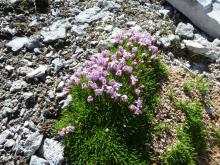
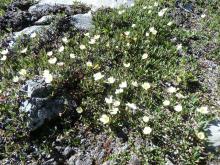
And finishing the climb, we are greeted with a view of the valley ahead and the first tarn, with low water after this warm summer. The hill overlooking it is often a welcome spot for lunch (and on the earlier of the two hikes, we sheltered in the lee side, out of the cool wind, with a view of the valley ahead).
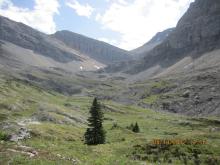
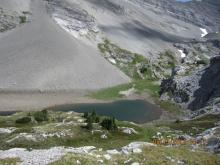
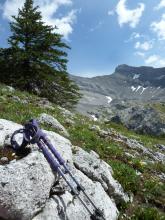
The hanging valley on the right side of the main valley was at the peak of bloom this year (it scarcely got to bloom at all last year!), spangled with yellow Arnica lonchophylla (or so I believe - let me know if it's some other arnica), Parnassia fimbriata and aster, and alive with dozens (hundreds?) of Milbert's tortoiseshell butterflies:

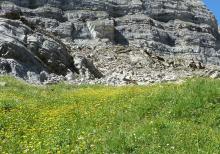

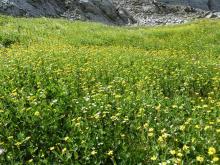
The valley ahead:
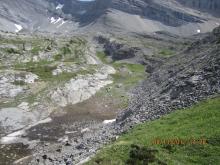
Mark McDonough
Re: Sparrowhawk Tarns, August 2012
Sun, 08/19/2012 - 5:35pmA wonderful hike with expansive views. Based upon the 4th photo in your last post, it is difficult to comprehend the enormity of those talus slopes. It makes me miss the days where I had such easy access to majectic mountains when I lived in Washington State.
Lori S. (not verified)
Re: Sparrowhawk Tarns, August 2012
Sun, 08/19/2012 - 7:32pmThanks for the comments, Mark!

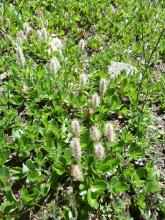
A few more photos...
Beautiful mats of Salix nivalis(?) amongst the rocks, and a patch of Salix that, surprisingly, was still in bloom:
Among the wildlife we saw were marmots, pikas, golden-mantled ground squirrels and this mama white-tailed ptarmigan, with her well-camouflaged brood of 5:
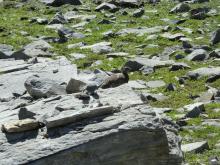
Tonestus (Haplopappus) lyallii with Castilleja; Smelowskia calycina x2; Agoseris aurantiaca:
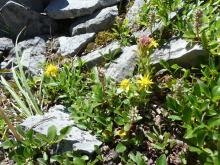
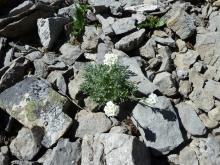
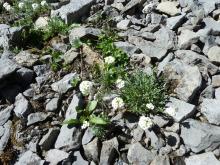
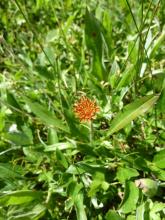
And the stunning expanses of Saxifraga lyallii that are a highlight of the bloom in this valley for us:
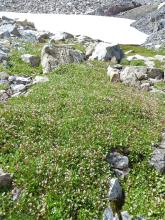

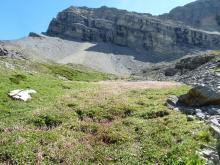
Trond Hoy
Re: Sparrowhawk Tarns, August 2012
Mon, 08/20/2012 - 1:46pmLori, it's marvellous! I am enjoying looking at your pictures and dreaming of walking there myself ;)
Tim Ingram (not verified)
Re: Sparrowhawk Tarns, August 2012
Mon, 08/20/2012 - 2:22pmSecond that! We are about as far away from any mountains as you can get in the UK.
Lori S. (not verified)
Re: Sparrowhawk Tarns, August 2012
Mon, 08/20/2012 - 8:47pmMore tarns along the way:
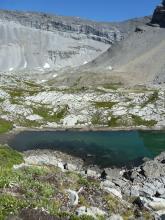
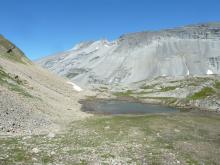
More flora - a rare Saussurea nuda still in bloom; meadow; Androsace septentrionalis; Saxifraga occidentalis:
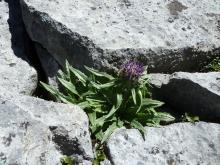

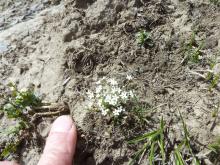
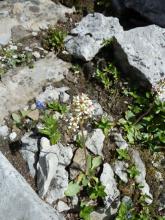
Last tarn, and for scale, that's me in the red shirt and backpack, seeing what's growing among the talus... :)
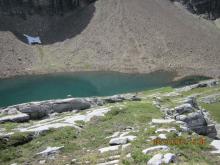
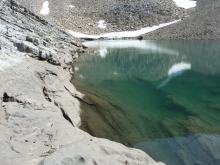


Howey (not verified)
Re: Sparrowhawk Tarns, August 2012
Tue, 08/21/2012 - 4:38amMark, I too miss the mountains in the west and only dream of them these days. As children we went on lots of hikes through the Sooke Hills (Vancouver Island) and I was able to go to one of the NARGS Annual Meetings in Snowbird, Utah - a dream come true up there among the Wasatch. In 2000, four of us ORGS folk spent a few days tramping around the Sierra Nevada east of Los Angeles. Once had a holiday in a Swiss Chalet but could only gaze at the Maiden, the Monk and the Ogre Alps from our deck - did go up to The Top of Europe in a slow train that plunged in and out of the mountain accompanied by piped in eerie music and terminating in some gorgeous views - but no actual hiking. I do so enjoy your pictures, Lori. Fran
Frances Howey
London, Ontario, Canada
Zone 5b
cohan (not verified)
Re: Sparrowhawk Tarns, August 2012
Tue, 08/21/2012 - 11:51amGreat stuff, Lori! We were in the mountains yesterday, and I could look up and see some of this sort of habitat, though not accessible from where we were (I did see one trailhead on the road to the Columbia Icefield that I need to look into, not sure where it goes, but there were slopes behind the forested parking area, though for all the cars there, I didn't see anyone up above...lol; and of course many of these sorts of slopes are simply not hikable- way too steep/unstable). Its been a wet year again here, and it seems so in the mountains west of me as well, since I saw green areas high up that I haven't seen before..
Interestingly, although there were some things in flower, there was a definite feeling of fall around the Columbia Icefield, with many shrubs/subshrubs starting to turn... I was curious to see some of the spring crucifers in seed, but the very few I could find were reduced to tiny winter rosettes!
Love the Saussurea and the Agoseris :) That Androsace seems larger flowered than those I've seen lower? or is it just because the stem is reduced?
Recently I posted somewhere that I'd read an article by the outgoing director of Banff National Park- he mentioned increased CO2 levels have led to a boost for shrubby over herbaceous species, and an impact on alpine flower meadows... have you seen this? I was thinking about this around the Icefield where there are more woodies than anything, but I don't have a long enough knowledge of the area and the habitat to know that that is anything other than typical...
Lori S. (not verified)
Re: Sparrowhawk Tarns, August 2012
Tue, 08/21/2012 - 12:20pmEven only from my minor efforts, I can say with certainty that you'd be surprised! ;) Give it a try sometime! It all looks impossible when you're looking up from below (in part, due to the foreshortening effect)... but just be aware that coming down is harder than going up.
Perhaps this is detectable over decades but I don't have that perspective.... having started this rather late in life, I may not live long enough to get it! ;D
cohan (not verified)
Re: Sparrowhawk Tarns, August 2012
Tue, 08/21/2012 - 12:43pmI was thinking (re:unhikable) of some that you can see from the road, with hundreds (?) of feet of cliff and/or endless talus slopes below the patches of green- I'll post some pics when I get that far; I'm sure there are those that you can get to (short of actual rock climbing/mountanineering!) via areas that are less extreme, but some I see only look accessible via helicopter...lol
So far its just been a matter of time as far as trying existing trails (not seriously contemplating picking a random mountain and trying to get up there...lol)- we can only do day trips, and it takes a couple/several hours driving just to get to the areas where you could begin a hike into the alpine- a couple hours each way hiking and then the drive home, starts to get too long.. there are supposed to be some areas near Nordegg ('only' 120km or so drive) where you can get up high, though the mountains aren't that high there, but I haven't figured it out yet... Not sure I'd be able to convince my driver to leave the vehicle unattended for any length of time unless its a busy parking lot, though he would love being up there... :-\
This trip we mostly skipped stopping in the foothills/montane areas so that we could get farther earlier, so we have another trip coming as far as Nordegg or Kootenay Plains...
Richard T. Rodich
Re: Sparrowhawk Tarns, August 2012
Tue, 08/21/2012 - 9:58pmOh the enormity of it all! :o
Without the people perspective, it just doesn't show. It's such a good thing that you put in these proportional photos now and then, Lori... and especially for us "flatlanders".
In southern Minnesota, the very steep (and often unclimbable) parts of south and west facing bluffs are often sparsely vegetated with fairly unique flora and fauna. They are usually termed "goat prairies" for obvious reason, although we have no wild goats, of course. From below they look like bald, lifeless sections of the bluffs.
cohan (not verified)
Re: Sparrowhawk Tarns, August 2012
Wed, 08/22/2012 - 3:01pmGoat prairies! I like that!
Lori S. (not verified)
Re: Sparrowhawk Tarns, August 2012
Wed, 08/22/2012 - 7:20pmI said I was going to keep this short but... ;D
Snuggled among the talus blocks with its roots in snowmelt was a colony of tiny

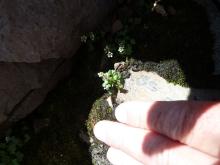
Romanzoffia sitchensis. ???? (Second photo to show scale!) Correction: Identified as Saxifraga rivularis on Jan. 21, 2013. Thanks, Mark!As always the big scree slope at the end of the valley dominates the view from a certain point, and must be explored. (One can also continue up the scree slope, and hang a right at the top of the rock band to make a loop of it on the Red Ridge "trail".)
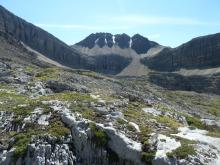
Climbing up the scree slope, my must-see plants were in bloom - Epilobium latifolium x2, Crepis nana, Senecio fremontii, Erigeron humilis x2, Phacelia sericea:

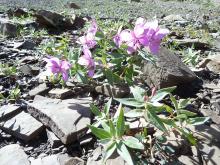


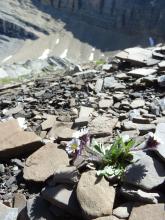
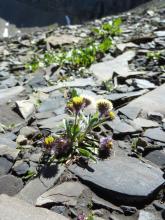
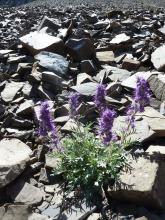
cohan (not verified)
Re: Sparrowhawk Tarns, August 2012
Wed, 08/22/2012 - 10:58pmMore cool stuff- the Romanzoffia is really tiny! love those :)
Epilobium latifolium was still in bloom at the Icefields, though I think I'd missed peak flowering; interestingly, just that bit lower in elevation (belwo the treeline, but not by all that much), the plants are much larger than the ones you show..
Nice Senecio; I photographed a couple of composites also that I'll be curious to see if you have any theories about..
Toole (not verified)
Re: Sparrowhawk Tarns, August 2012
Fri, 08/24/2012 - 2:33amThanks for posting Lori
Won't be long ,hopefully less than 3 months :-\ , until i can get out on the 'hills' down here again .In the meantime your pics and comments ,as well as from others, are a real 'pick me up' . :)
Cheers Dave.